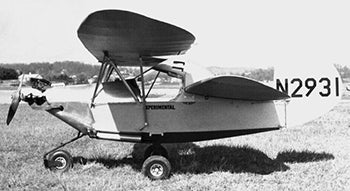 |
| STANDARD DATA (FLYING FLEA): Gross weight: 700 lbs.; Empty weight: 410 lbs.; Fuel capacity: 12 gals.; Wingspan: 20 ft.; Length: 14 ft. PERFORMANCE: Top speed: 105 mph; Stall speed: 35 mph; Climb rate: 500–600 fpm; Service ceiling: 16,400 ft.; Range: 275 nm. STANDARD DATA (AMF S-14): Gross weight: 1,500 lbs.; Empty weight: 1,000 lbs.; Fuel capacity: 18 gals.; Wingspan: 32 ft.; Length: 23 ft. STANDARD DATA (MUSTANG P-51): Gross weight: 1,985 lbs.; Wingspan: 24 ft. 8 in. |
For Chris Falconar, what began as a simple introduction to the H14 Flying Flea in a Montreal department store in 1935, resulted in a lifelong fascination with aircraft design. Falconar added a fleet of flying homebuilts to the world, ranging from the most simple to high-performance variants of the North American P-51 Mustang. He was awarded for outstanding achievements by the EAA at AirVenture Oshkosh.
The first Flying Flea took to the air back in 1933 and quickly earned a reputation for being tempermental. The version pictured above is an authentic copy of the original biplane built by Mignet, except for the installation of a 72 hp McCulloch engine and two minor rigging changes. Mignet was a furniture manufacturer, and he impishly named his creation “LePou de Ciel,” or “Louise of the Sky.” It started out to be “Everyman’s Airplane,” which could be built for $500 (complete) in the Great Depression years. Mignet’s Flea carried a 17 hp engine and had a speed range from 25 mph to 62 mph.
The AMF S-14 is a two-place taildragger modeled after the Adam RA-14. The S-14 was first flown in 1961. It’s powered by 85 hp to 150 hp engines. Its fuselage is a conventional wooden box-girder structure covered with plastic-coated fabric. The 514’s wings are a braced high-wing design of all-wood and fabric with STOL characteristics.
The kit Mustang is composed from wood and fabric, but includes a jettisonable canopy, removable fiberglass belly scoop, electrical or manual flaps and a retractable tailwheel.
The most common Falconar are still the more conventional “F” series. The simplest construction begins with the single-seat F9A, which often flies with small two-stroke engines. The F10A is a beefier model that’s designed to use a Continental engine. The F11A “Sporty” adds a side-by-side, two-seat cockpit, and the F12A “Cruiser” adds a third seat.



